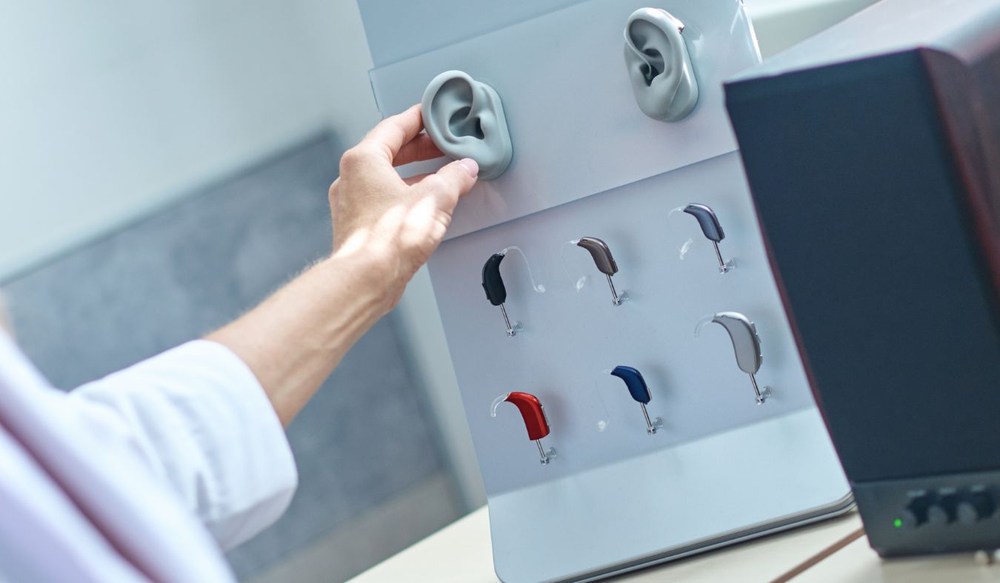Innovations in Hearing Aid Battery Technology
Battery technology has come a long way in recent years, and these

By: admin | November 18, 2025
Battery technology has come a long way in recent years, and these improvements directly affect how reliably your hearing aids perform throughout the day. Running out of battery power at an inconvenient time, whether you’re in the middle of an important conversation, attending a concert or traveling, creates frustration and leaves you struggling to hear clearly when you need your devices most. Modern advancements in hearing aid batteries focus on extending how long they last, making them easier to use and reducing the anxiety that comes with wondering whether your devices will make it through the day.
Better battery technology also simplifies the practical side of wearing hearing aids. You spend less time changing batteries, worrying about carrying spares or planning your day around when your devices might need attention. Whether you’re using traditional disposable batteries or rechargeable options, newer technology offers more reliable performance and greater convenience. This reliability matters because it allows you to focus on your activities and conversations rather than constantly monitoring your battery life or dealing with unexpected device failures. These improvements mean fewer interruptions, less time spent managing your hearing aids and more consistent access to the clear hearing you depend on in your daily routine.
Hearing aids are designed to amplify and clarify the sounds you want to hear, helping your brain interpret speech and other important noises more easily. At a basic level, they pick up sound through a small microphone, process it using internal electronics and deliver the adjusted sound into your ear through a receiver. Modern hearing aids do much more than simply make everything louder, they analyze the environment around you and adjust the sound so speech stands out from background noise. This allows you to follow conversations in busy or noisy settings without constantly straining to listen.
The processing inside hearing aids happens almost instantly. Advanced digital systems separate speech from other sounds, reduce feedback and adapt to different listening environments. Some hearing aids can even recognize specific situations, like restaurants, meetings or outdoor areas, and automatically modify the sound to provide the clearest listening experience.
These adjustments can be personalized based on your hearing test results, lifestyle and preferences, ensuring that your devices meet your unique listening needs. With the right fit and programming, your hearing aids support your daily activities by providing consistent, natural-sounding amplification that helps you stay connected to conversations, entertainment and important environmental sounds.
The type and quality of battery you use have a direct impact on how well your hearing aids perform. Fresh batteries provide steady power, allowing the devices to amplify sound consistently. Different hearing aid styles, like behind-the-ear or in-the-ear models, can draw power at different rates, so the same battery may last longer in one style than another.
Environmental factors also affect battery performance. Cold temperatures can slow the chemical reactions inside the battery, causing it to lose power more quickly, while hot or humid conditions can similarly shorten its lifespan. These fluctuations can lead to sudden drops in amplification or changes in sound clarity, which may make it more difficult to follow conversations or hear subtle environmental sounds. The performance of a battery is a key factor in how well hearing aids function throughout the day.
Traditional zinc-air batteries are commonly used in hearing aids because they provide steady power in a small package. These batteries use oxygen from the air to create energy, which is why they come sealed with a sticker that you peel off before use.
Once the sticker is removed, air enters the battery, allowing oxygen to react with zinc inside and produce power. This process continues until the zinc is used up. Keeping unused batteries sealed and stored in a cool, dry place helps ensure they remain fresh until you need them.
Zinc-air batteries can lose power quickly if exposed to air for too long before use. This often means shorter battery life and more frequent replacements, which can interrupt your daily routine.
These batteries may also be less dependable in extreme temperatures or humid conditions. Some people find handling small batteries difficult, especially if they have limited finger strength or dexterity. Frequent replacements can add extra steps and frustration for those who depend on their hearing aids every day.
Innovations in battery materials are making hearing aid batteries last longer and work better. Newer options like lithium ion and silver zinc can store more energy in a smaller size.
Some of the benefits include longer battery life between charges or changes, faster charging times for rechargeable batteries, lighter weight for greater comfort and more stable performance across different temperatures. These improvements make it easier to rely on your hearing aids throughout the day without worrying about sudden power loss.
Rechargeable hearing aid batteries have become a popular choice because they are simple to use and can save you time. Most are built directly into the hearing aids, so there is no need to handle tiny battery doors or worry about dropping small batteries. Many models can be charged overnight, providing a full day of use after just a few hours on the charger.
Charging stations are often included, making daily charging as easy as placing your devices in their dock. Rechargeable batteries can last several years before needing replacement, reducing trips to buy new batteries. Some rechargeable hearing aids also offer features like water resistance or wireless connectivity for added convenience.
Despite these benefits, rechargeable batteries do have some drawbacks. They may provide slightly less power than disposable batteries in certain situations, which can affect performance in high-demand devices. Over time, the battery’s capacity can gradually decrease, meaning the hearing aids may not last a full day between charges. Additionally, if the battery runs out while you are away from a charger, you cannot simply swap in a new one, which can be a limitation in extended outings or travel.
Fast charging has changed how people use rechargeable hearing aids. With this feature, you can get hours of use from just a short time on the charger.
This makes it easier to keep up with your daily activities, even if you forget to charge your hearing aids overnight or need a quick boost before heading out. Fast charging reduces stress about running out of power and helps you stay connected without long interruptions.
Several factors influence how long your hearing aid batteries last. The amount of time you use your hearing aids each day, as well as environmental conditions like humidity, heat and cold, can all affect battery life.
To help your batteries last longer, store them in a cool, dry place and keep the battery doors open when not in use to let moisture escape. Always handle batteries with clean, dry hands to avoid dirt or oil that can lower performance.
There are important differences between disposable and rechargeable hearing aid batteries when it comes to the environment. Disposable batteries are used once and then thrown away, which creates more waste over time.
Rechargeable batteries, on the other hand, can be used for several years before needing replacement, leading to fewer batteries ending up in landfills. Choosing rechargeable options may help reduce the number of used batteries that require special handling or recycling.
Proper handling and storage of hearing aid batteries helps keep you and others safe. Always store batteries in their original packaging or a secure container, away from coins, keys or other metal objects that could cause them to short circuit. Keep them out of reach of children and pets, as swallowing batteries can be dangerous.
When changing batteries, use clean, dry hands to avoid moisture or dirt affecting performance. Place used batteries in a safe spot until they can be properly recycled—never dispose of them with regular trash.
Traveling with hearing aid batteries can be stressful if you are concerned about running out of power away from home. Bringing more batteries than you think you will need can help prevent interruptions during your trip.
It is best to keep batteries in your carry-on bag when flying, as airport security usually does not pose an issue. Changes in temperature and pressure on planes can affect battery life, so storing them in a cool, dry place helps maintain their performance. Always check the rules for carrying batteries if you are traveling internationally, as some countries have different guidelines.
Pack your batteries in their original packaging or a secure container to prevent accidental short circuiting. If you use rechargeable hearing aids, remember to bring the charger and any necessary adapters for international outlets. Planning ahead helps ensure your hearing aids stay powered so you can enjoy your travels without missing important sounds or conversations.
Modern hearing aids often include alerts to let you know when the battery is running low. These may be soft beeps, a voice message or a blinking light, depending on your device.
Paying attention to these signals gives you time to change or recharge your batteries before the power runs out. Becoming familiar with how your device signals low battery helps you avoid surprises. Checking the user manual or asking your audiologist about these warnings can make daily use more reliable.
A few small changes to your daily routine can help your hearing aid batteries last longer. Turn off your hearing aids when not in use, especially overnight, and open the battery door to let moisture escape. Store unused batteries in a cool, dry place and keep them sealed until needed.
Always use clean, dry hands when changing batteries to prevent dirt or oil from affecting performance. These steps can help your batteries work better and last as long as possible.
Advances in hearing aid battery technology have made a noticeable difference in day-to-day hearing experiences. Reliable batteries reduce the interruptions that can come from sudden power loss and allow you to engage more fully in conversations, work and leisure activities. With longer-lasting and more consistent performance, you can focus on the moments that matter rather than worrying about whether your devices will keep up with your schedule. Whether attending social gatherings, traveling or simply enjoying everyday activities, better battery technology supports smoother, more predictable hearing.
Having dependable batteries also makes it easier to integrate hearing aids into your routine without constant concern over maintenance or power issues. Whether you prefer traditional disposable batteries or rechargeable models, these innovations provide peace of mind and uninterrupted access to sound. For guidance on the best battery options for your hearing aids and how they fit into your lifestyle, reach out to ChEARS Hearing Center in San Diego, CA at (619) 717-2601.
Tags: benefits of hearing aids, hearing aid features, hearing aid technology

Battery technology has come a long way in recent years, and these
By: admin | November 18, 2025

Hearing care has changed significantly in recent years, going beyond the
By: admin | September 24, 2025

Hearing aids have come a long way from being simple sound amplifiers –
By: admin | May 23, 2025
